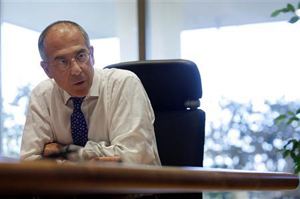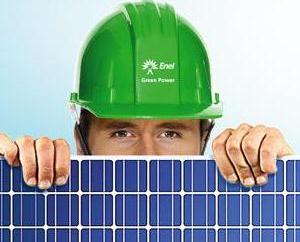"We have shifted investments to places where demand is growing"
on
Francesco Starace, Chief Executive Officer of Enel Green Power, puts brakes on European expansion
"We have shifted investments to places where demand is growing"
It wouldn't make sense for European government to push for growth in renewable energy at this moment in time, says Francesco Starace, chief executive officer of Enel Green Power (EGP), the renewable energy arm of giant Italian utility Enel. Overcapacity and stagnant demand in a number of European markets - including EGP's core markets Italy and Spain/Portugal - means cuts in renewable energy incentives are logical, Starace says in an interview with European Energy Review. Even without incentive cuts, he adds, EGP would have pursued its current strategy, which sees the renewable group temporarily scaling back growth in Europe and pursuing growth in emerging markets instead.
 |
| Francesco Starace, Chief Executive Officer of Enel Green Power (c) planetark.org/ Alessia Pierdomenico |
"We'd like to invest more in Europe but in this environment, it doesn't make much sense to make major new investments here", says Starace. "Instead, we've decided to shift our investments to places where demand for electricity is growing." For EGP, this means an increased focus on emerging markets, with projects planned in countries like Brazil, Chile, Mexico, Turkey, South Africa and Morocco over the lifetime of EGP's 2012-2016 business plan (see box at the end of the article).
Enel Green Power was set up as a dedicated subsidiary of the Italian utility Enel in December 2008. Just over 30% of the shares were sold in a €2.6 billion initial public offering on the Milan and Madrid exchanges in October 2010. Starace has been with the Enel group since 2000 and initially served as EGP chairman following the group's creation in 2008. Since September 2010, he has held the position of CEO. At end-2011, the company boasted a net installed capacity of approximately 7.1GW in plants located in 15 countries, making it one of Europe's largest renewable energy producers.
Starace sums up EGP's strategy as follows: "We look for situations in which the combination of electricity demand and high costs in thermal power mean that renewable energy can be competitive on the market without incentives." This does not mean the company sees absolutely no role for incentives. "What we believe is that incentives should be gradually reduced as renewables are approaching grid parity. But reductions should not be retroactive in order to secure a stable framework for those who have already planned investments."
This is the reason why EGP has stayed away from offshore wind in Europe: the company believes the high costs of offshore wind energy mean that sufficient returns on investment can only be found in
| "We simply think offshore wind, at the current state of development, does not constitute a real opportunity in the Mediterranean area" |
Bottom
It will likely take another three or four years, Starace believes, until major growth opportunities are seen again in Europe in any renewable energy technology. "First it will take time for the economy to recover and then for the gap between power supply and demand to close", Starace says. Longer term prospects for renewable in Europe are generally positive, he adds. EGP believes installed renewable capacity in Europe could rise to as much as 1000 GW by 2020, more than doubling from the 460 GW seen at end-2011.
Starace stresses that his company is not abandoning Europe, where EGP boasted net installed capacity of 5.4 GW at end-2011, 76% of a 7.1 GW total, and sourced 72% of its 22.5 TWh in electricity production. Even in 2016 the company expects 58% of its forecasted total of 38.5 TWh of electricity production to come from European plants.
"What's important in Europe is that there is a proven and reliable legal and regulatory system, which guarantees returns on the investments we've made", Starace says. He believes fears of retroactive changes to incentive schemes in Italy, which are in the process of being revised, and other European markets are unfounded.
Starace notes that the need for EU member states to make progress towards renewable energy targets laid out for 2020 in national renewable energy action plans will help the bottom from falling out of the market in the short term. "The targets are important but they need to be achieved through a sound policy framework at the European and national level and increased coordination between member states."
Demographic growth
By contrast, Starace sees significant growth opportunities in a number of emerging markets, based not only on economic but also demographic growth. "The lion's share of the emerging markets we are targeting show growth in electricity demand that is being led both by economic and demographic growth, while in Europe electricity demand tends to be related more closely to economic growth alone."
But the emerging markets targeted by EGP have other assets as well: ample renewable energy resources as well as a reliable regulatory and legal framework. "Certainly, the latter is not found in all emerging markets", Starace says. Positive examples are Colombia and Peru, where EGP is scouting for opportunities in all of its four core renewable energy sectors.
In the US, EGP's investment strategy is closely tied to current expectations for the expiry dates of the various Production Tax Credits (PTC). For the time being, EGP's investments in the US are heavily weighted towards wind energy, given that the PTC for wind is now set to expire at end-2012. Subsequently, EGP's investment focus in the US will shift to geothermal (with a 2013 PTC expiry date) and solar PV (2016 expiry date). Nonetheless, Starace believes that PTC extensions are likely. "It's the third time we've arrived at this appointment and, after a period of debate, I believe they will be renewed."
With new projects coming online through 2016, Starace says EGP believes it can maintain the average load factor for its renewable energy plants at the 40% figure posted in 2011. Capacity factors for new wind energy projects in emerging markets are expected to come in at as high as 40-45%, a figure largely unheard of in Europe and well above the 24% wind capacity factor for EGP's existing assets. On the downside, this is expected to be balanced by lower capacity factors for future geothermal and hydro projects than those in EGP's current portfolio. These now stand respectively at around 82% and 45%.
Diversification
One of EGP's calling cards is its technological diversification. At end-2011, EGP had 3.5 GW of installed wind capacity globally, 2.5 GW of hydroelectric power, 769 MW of geothermal power, 101 MW of solar PV and 128 MW biomass and other renewable energy sources. The company last year produced roughly 45% of its 22.5 TWh of electricity production from hydroelectric power, 27% from wind, 25% from geothermal power, three percent from biomass and less than one percent from solar PV.
In 2016, wind energy should become the most important power source for EGP, with the relative weight of hydroelectric and geothermal power falling. Both solar PV and biomass should each account for 2% of the electricity production total that year.
While solar PV will continue to make up a relatively small portion of EGP's overall portfolio, its expected growth rate over the next five years is nonetheless impressive. Solar PV is expected to account for 5% of the group's installed capacity in 2016 compared to less than one percent now and its share of the company’s electricity production pie should more than double.
The company says it has a strong commitment to solar PV in all of the geographical areas it is present, from Europe to North America and emerging markets. "In Europe, the scenario is very positive", says Starace, pointing to indications from the European Photovoltaic Industry Association (EPIA) that the entire European solar PV sector could reach grid parity by 2020.
EGP's home Italian market will be the testing ground for a possibly deeper foray into biomass energy.
| "The preferred strategy for most investors in biomass has been to build large plants, with raw materials transported by sea, which is very expensive and pollutes extensively" |
In Italy, EGP is also working on plans for a hybrid geothermal-biomass plant. "Every time we are able to exploit different renewable sources at the same time, we create value", says Starace. The company's North American subsidiary last month inaugurated the world's first geothermal binary cycle-solar hybrid plant in Churchill County, Nevada, a 59MW facility.
Especially critical
Where it sees a competitive advantage from doing so, EGP has also carved out a niche for itself in renewable energy technology. This is not the case in either wind or hydroelectric power, where Starace notes technological changes are occurring at a relatively slow pace and the company sees no room for creating value by being involved in the technological side of business.
In the PV business, however, EGP has set up the 3Sun joint venture with Sharp and STMicroelectronics
| "In solar PV, it's important to be present in the production chain because there are rapid-fire changes in technology and lots of creativity and innovation going on" |
EGP also stands out for its integrated presence in the geothermal sector - from exploration to production - in which it has a century-old tradition. That know-how is increasingly being used outside of its home market. The company recently received environmental assessment clearance for a geothermal project in Chile which will be the first geothermal plant in South America. "We are also exploring other sites in the country", says Starace. Geothermal exploration is also underway in Turkey.
When it comes to the integration of renewable energy sources, Starace points to the need to improve day-after forecasting for both wind and solar energy. "Technology is already helping out in this respect", he notes. The problem of feeding wind and solar power into the grid has become especially critical in a European market characterized by overcapacity, Starace says.
He believes the need to find solutions for integrating increasing quantities of renewable power could also help give European firms a competitive advantage. In wind energy, a frequently cited success case is that of Spain, which uses a dedicated control centre and a very sophisticated forecasting system to fine-tune the quality of forecasts. "The development and export of this sort of technology and know-how could be a good way for European companies to establish a footprint abroad", says Starace. And to help compensate for weaker markets at home.



Discussion (0 comments)